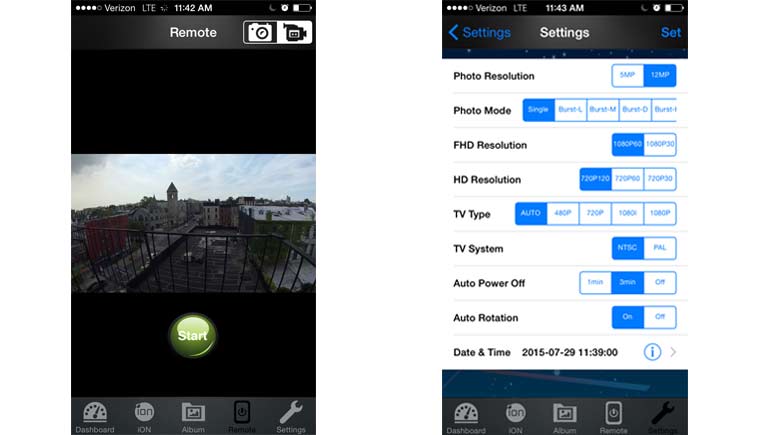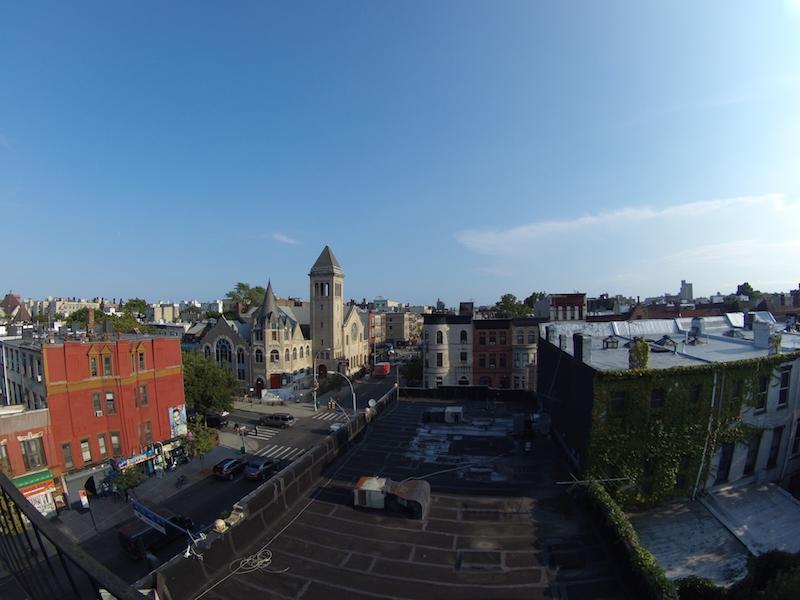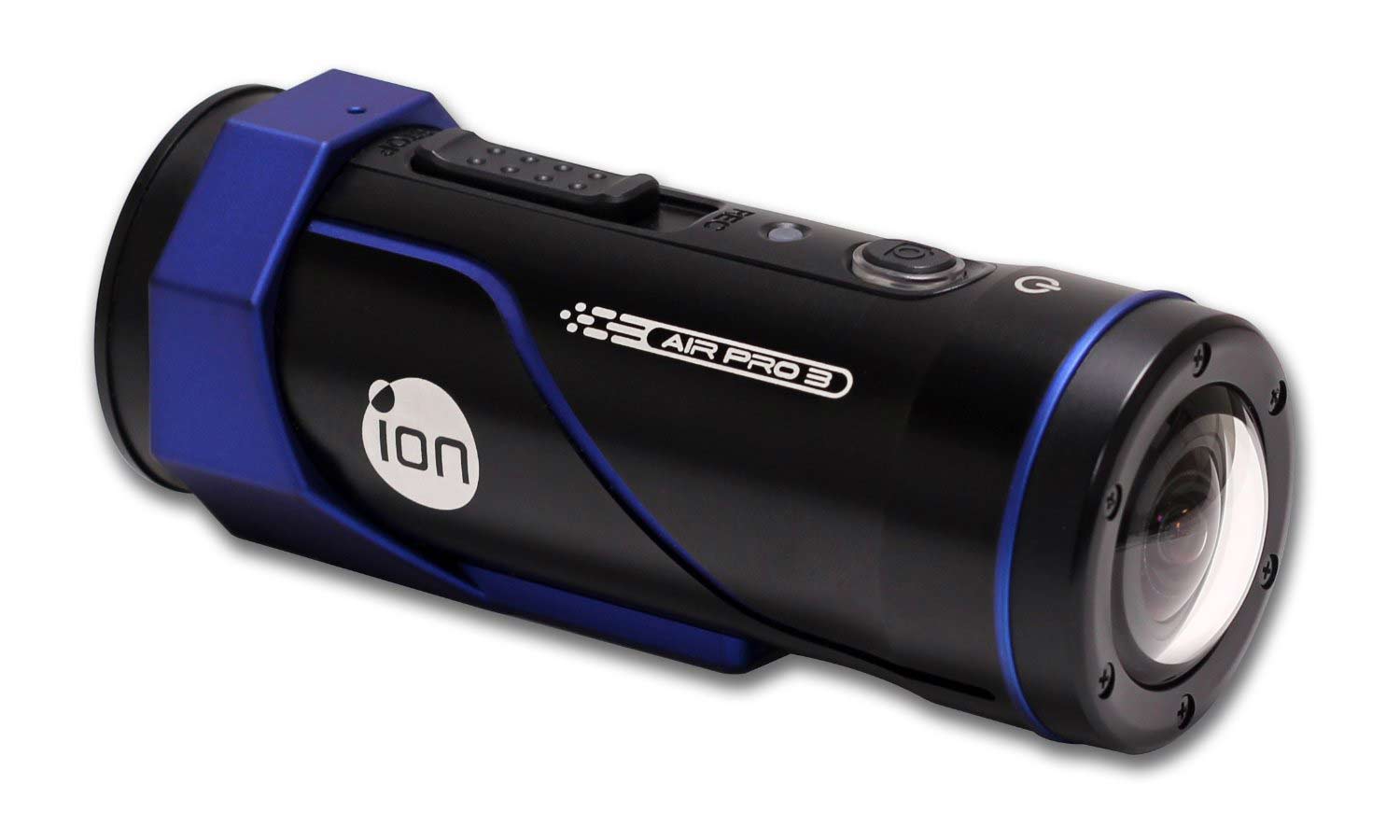Tom's Guide Verdict
The Air Pro 3 has a clever, rugged design, good controls and respectable performance, but you can get better image quality at this price.
Pros
- +
Stylish, waterproof design
- +
Fairly sharp videos and stills
- +
Easy to operate
- +
Video up to 1080p/60fps and 720p/120fps
Cons
- -
Some competitors shoot better video for lower prices
- -
Microphone picks up too much wind noise
Why you can trust Tom's Guide
The Ion Air Pro 3 has probably the most bling you'll find in an action camera, with a two-toned contoured design. More than its sharp looks, the Air Pro 3 is waterproof as-is, with no need for a separate housing. Controls are easy to operate, and the video and photos it shoots are perfectly usable. But, at $241, it faces some stiff competition from cheaper cameras.
Design: Super Rugged
The Air Pro 3 looks like the sports car of action cameras — in the slightly tacky American-style way of, say, a Camaro. The two-tone chassis is predominantly black, with a metallic-blue mounting bracket and accent stripes.
A glass bubble over the lens provides plenty of protection and, combined with the watertight cap on the back, allows the camera to dunk an impressive 15 meters (about 49 feet) underwater without requiring a separate housing. That beats other housing-free cameras like the Kodak Pixpro SP1 which goes to 10 meters (33 feet) and even Sony's cameras, such as the Sony HDR-AS200V which goes only to 3 meters (9 feet) when in its case.
Considering the Air Pro 3's ruggedness, its hefty 5-ounce weight is reasonable. It's a bit less than both the Kodak SP1 (5.4 ounces) and the GoPro Hero 4 Silver in its waterproof case (5.2 ounces).
Controls and Usability
Like the Roam3 from Contour (which just merged with Ion), the Air Pro 3 has simple controls that are easy to use even without a screen. A slider switch atop the Air Pro 3 turns the camera on and begins video recording. A button further forward snaps photos with a short press and can turn the camera on or off if held down for a few seconds. A cellphone-like vibrating action (as well as LEDs) signal when the camera is powering on or off.
MORE: GoPro Hero4 Silver Action Camera Review
Unlocking and releasing a cap on the back reveals the card slot, ports and a switch for flipping between full HD recording (1080p) up to 60fps and HD (720p) recording at up to 120fps for slow-motion playback. These are good frame rates for a camera at this price: Some competitors don't have the power to shoot beyond 1080p/30fps or 720p/60fps.

The rear cap doesn't just provide a water seal, it also contains the camera's wireless module, called (for some reason) the Wi-Fi Podz. The mobile app (Android and iOS) provides not just a live preview and remote trigger but also control over camera settings such as photo and video resolution; so you won't have to fuss with controls on the camera if it's mounted where you cannot easily reach it. You can't make any image-quality adjustments such as white balance: Those are all pre-set.
Video and Photo Quality: Midrange
It's not up to the quality of more-expensive GoPro and Sony cameras, but the Ion Air Pro 3 captured fairly crisp, well-exposed video and 12MP stills of the view from my apartment in Brooklyn.

I generally used the Air Pro 3's Superwide 160-degree field-of-view setting.
Were it not for even better quality by the roughly same-priced Kodak Pixpro SP1 and Sony HDR-AS200V, the Air Pro 3 might be the champ of budget action cameras. Both the Kodak and Sony, as well as the $399 GoPro Hero4 Silver, capture better detail, especially when the camera is moving and bouncing around, as when mountain biking. (With electronic image stabilization, the Sony video is exceptionally steady.)
A bigger problem is excessive wind noise. A stretch of California mountain-bike trail with nearly still air sounded like the inside of a wind tunnel in Air Pro 3 video, while other cameras running simultaneously captured barely a hiss (while still picking up the rattle of the bikes and voices of riders just fine). The camera does have a jack for an external microphone, which should make a bigger difference here than with other cameras. But using it requires removing the Wi-Fi Pods, disabling both Wi-Fi and the waterproofing.
Low-light video shot on a challenging dim Brooklyn street was roughly on par with that of other action cameras, though tinted excessively amber.
A still photo of the same scene was refreshingly bright and crisp (given the circumstances), though also a bit amber.

Keep in mind: You probably won't be shooting a lot of action sequences in the dark. Surfing, skiing, biking, etc. are mostly daytime activities.
Battery Life and Storage
The Ion Air Pro 3 battery is not removable. That's generally good, as enables the camera to be compact and waterproof (without an extra case); but it does mean you can't swap in a spare battery if you are running low. With enough juice for about 2.5 hours of 1080p/60fps video, though, you may not need more. (The Kodak Pixpro SP1 lasts for 2 hours 10 minutes shooting at just 1080p/30fps.)
The microSD card slot accepts chips up to 64GB, enough for about a generous 4 hours, 20 minutes of 1080p/60fps video.
Accessories
The Air Pro 3 chassis features a screw hole for mounting to a tripod, including the basic tabletop model that comes bundled. A bracket that attaches to the mount allows the camera to lock into Ion's mounting system, such as the included bike-helmet mount with a locking ball joint for angling the camera at a wide sweep of directions. This mounting system does position it rather high up, so watch you don't catch it on things like low tree branches.
Ion sells a good basic assortment of upgrade mounts, including for headbands, handlebars and surfboards.
Bottom Line
The Ion Air Pro 3 could be the right action camera for someone who wants hassle-free deep-water recording without spending too much. It goes deeper than competitors from Kodak and Contour without requiring an extra case. In terms of pure video quality, I prefer the GoPro Silver, which costs about $150 more, but also includes a touchscreen display. If diving isn't your top priority, you might do better with cheaper competitors such as the Kodak Pixpro SP1 or the Sony HDR-AS200V. For recording your underwater activities, the Air Pro 3 could be a good option.
Sean Captain is a freelance technology and science writer, editor and photographer. At Tom's Guide, he has reviewed cameras, including most of Sony's Alpha A6000-series mirrorless cameras, as well as other photography-related content. He has also written for Fast Company, The New York Times, The Wall Street Journal, and Wired.

